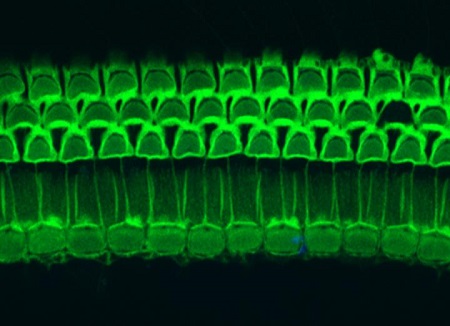Approximately 80 percent of infants in neonatal intensive care units receive antibiotics known to be toxic to the ear.
Oregon Health & Science University - Portland, Ore. - Seeking to stem the tide of permanent hearing loss from the use of life-saving antibiotics, researchers at Oregon Health & Science University have found that patients stricken with dangerous bacterial infections are at greater risk of hearing loss than previously recognized. Inflammation from the bacterial infections substantially increased susceptibility to hearing impairment by increasing the uptake of aminoglycoside antibiotics into the inner ear, the researchers report. Their findings are published in online in the journal Science Translational Medicine.

This is an image of the (intact) organ of Corti, with three rows of outer hair cells, and one row of inner hair cells, separated by a row of pillar cells. Green is Alexa-488 phalloidin labeling of F-actin, and Blue is Hoescht labeling of nuclei. CREDIT: Steyger Lab, OHSU.
"Currently, it's accepted that the price that some patients have to pay for surviving a life-threatening bacterial infection is the loss of their ability to hear. We must swiftly bring to clinics everywhere effective alternatives for treating life-threatening infections that do not sacrifice patients' ability to hear," said Peter S. Steyger, Ph.D., professor of otolaryngology, head and neck surgery, Oregon Hearing Research Center, Oregon Health & Science University School of Medicine. "Most instances in which patients are treated with aminoglycosides involve infants with life-threatening infections. The costs of this incalculable loss are borne by patients and society. When infants lose their hearing, they begin a long and arduous process to learn to listen and speak. This can interfere with their educational trajectory and psychosocial development, all of which can have a dramatic impact on their future employability, income and quality of life."
Aminoglycosides, antimicrobials that are indispensable to treating life-threatening bacterial infections, are toxic to the ear. Relied on by physicians to treat meningitis, bacteremia and respiratory infections in cystic fibrosis, aminoglycosides kill the sensory cells in the inner ear that detect sound and motion.
Infants in neonatal intensive care units, or NICUs, are at particular risk. Each year, approximately 80 percent of 600,000 admissions into NICUs in the United States receive aminoglycosides. The rate of hearing loss in NICU graduates is 2 to 4 percent compared with 0.1 to 0.3 percent of full-term births from congenital causes of hearing loss.
When Steyger and colleagues gave healthy mice a low amount of aminoglycoside, the rodents experienced a small degree of hearing loss. If the mice had an inflammation that is typical of the infections treated with aminoglycosides in humans, the mice experienced a vastly greater degree of hearing loss.
The study lays the groundwork for improving the standard of care guidelines for patients receiving aminoglycosides. To shield patients' hearing, the researchers called for the development of more targeted aminoglycosides and urged clinicians to choose more targeted, non-ototoxic antibiotics or anti-infective drugs to treat patients stricken with severe infections.
Due to their widespread availability and low cost, aminoglycosides are used frequently worldwide. Clinical use of aminoglycosides is limited due to the known risk of acute kidney poisoning and permanent hearing loss, yet are crucial life-savers in cases with potentially fatal infections.
Scientists who contributed to the OHSU study, "Endotoxemia-mediated inflammation potentiates aminoglycoside-induced ototoxicity," include: Steyger; Ja-won Koo, M.D., Ph.D.; Lourdes Quintanilla-Dieck, M.D.; Meiyan Jiang, Ph.D.; Jianping Liu, M.D., Ph.D.; Zachary D. Urdang, B.S.; Jordan Allensworth, B.S.; Campbell P. Cross, B.A.; and Hongzhe Li, Ph.D.
This research was supported by: National Research Foundation of Korea grant 2011-0010166; Seoul National University Bundang Hospital 03-2011-007 (J.K.W.); National Institute of Deafness and Other Communication Disorders R01 DC004555, R01 DC12588 (P.S.S.), R03 DC011622 (H.L.), and P30 DC005983; and the Department of Otolaryngology at OHSU (L.Q.D.).
About OHSU
Oregon Health & Science University is a nationally prominent research university and Oregon's only public academic health center. It serves patients throughout the region with a Level 1 trauma center and nationally recognized Doernbecher Children's Hospital. OHSU operates dental, medical, nursing and pharmacy schools that rank high both in research funding and in meeting the university's social mission. OHSU's Knight Cancer Institute helped pioneer personalized medicine through a discovery that identified how to shut down cells that enable cancer to grow without harming healthy ones. OHSU Brain Institute scientists are nationally recognized for discoveries that have led to a better understanding of Alzheimer's disease and new treatments for Parkinson's disease, multiple sclerosis and stroke. OHSU's Casey Eye Institute is a global leader in ophthalmic imaging, and in clinical trials related to eye disease.
Source: https://www.eurekalert.org/pub_releases/2015-07/ohs-air072715.php

